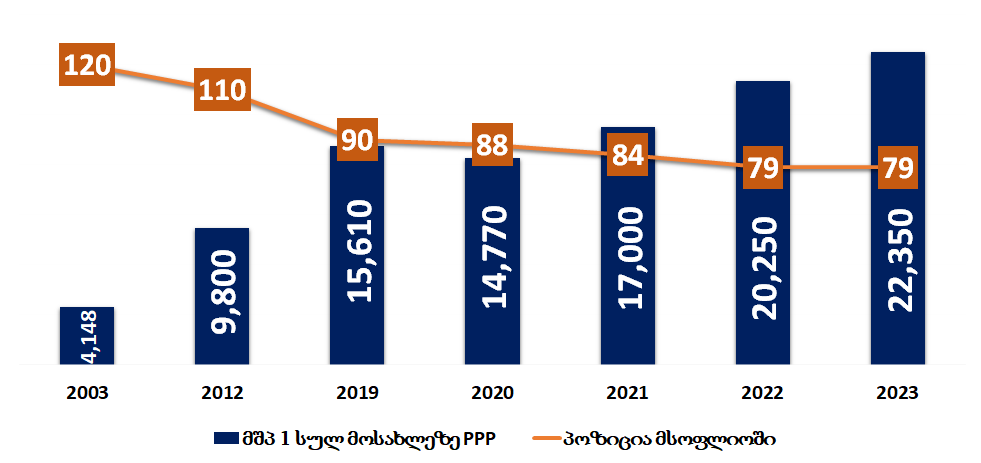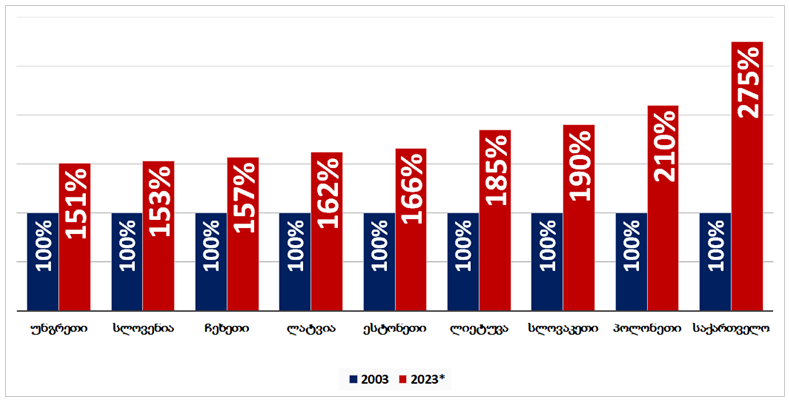Irakli Kobakhidze: “Georgia surges from 110th to 79th in the GDP per capita ranking over 2012-2023, achieving a 7.5-fold economic growth from 2003 to 2023.”
Verdict: FactCheck concludes that Irakli Kobakhidze’s statement is HALF TRUE
The Georgian GDP per capita at purchasing power parity (PPP) increased from USD 9,800 in 2012 to USD 22,350 in 2023, advancing the country from the 110th to the 79th position in the world, according to the International Monetary Fund data.
The Georgian economy, as an advancing economy, demonstrated higher growth as compared to the world or the EU in the early 1990s with similar positional advancements observed from the 120th to the 110th position in 2003-2012. Georgia indeed surpassed 30 countries in terms of the nominal per capita GDP (PPP) during the governance of the Georgian Dream political party.
Whilst the MP does not specify the years from 2003 to 2012, he asserts that the Georgian economy expanded 7.5-fold from 2003 to 2023, outpacing the progress of European countries. Although the nominal economy did indeed expand 7.5-fold over the period from 2003 to 2023, the real economy only witnessed a 2.8-fold increase.
Thus, the statement underlining the higher growth rate of the Georgian economy as compared to the world and leading to an improvement in the GDP per capita rankings, is accurate. However, the latter half of the MP’s statement refers to the economy expanding 7.5-fold which is correct for nominal terms but only 2.8 upon adjusting for inflation.
Irakli Kobakhidze correctly stated that there is a GDP per capita (PPP) growth trend but, nonetheless, he utilised nominal data to display the country’s economic advancements, overstating the actual growth as well as the achievement relative to the countries mentioned in the statement. Despite indicating that he refers to nominal values, this approach could still be misleading. Considering all of the above, FactCheck has evaluated Irakli Kobakhidze’s statement as HALF TRUE.
Analysis:
Irakli Kobakhidze published a comprehensive social media post, highlighting the advancements of the Georgian economy over past two decades, particularly under the governance of the Georgian Dream. He emphasises the improvement in Georgia’s position, surpassing 30 countries in the GDP per capita ranking: “According to the International Monetary Fund’s data, Georgia has surpassed 30 countries in terms of economic indices in 2023 as compared to 2012, surging from the 110th to the 79th position. This indicates that Georgia has advanced not in the absolute aspect but also in comparison to other countries as well. The nominal economies of Lithuania, Latvia and Estonia have quadrupled, those of Poland, the Czech Republic and Slovakia have tripled whilst Slovenia and Hungary have witnessed a two-fold growth. However, it is noteworthy that, according to the same World Bank data, Georgia did not expand two-fold, three-fold or four-fold but by 7.5-fold over the same period. The data indicate that the underlying aspect of the country’s fast economic growth is the government policy rather than membership in any union.”
Irakli Kobakhidze utilises the purchasing power parity (PPP) method in his analysis, citing the International Monetary Fund as his source. The PPP approach aims to equalise the differences in prices of the same range of products and services across countries.
According to International Monetary Fund data, the GDP per capita adjusted for PPP was USD 9,800 in 2012, positioning the country in the 110th place globally. In addition to more advanced countries, Georgia was also surpassed by Indonesia, Mongolia, Ecuador, Botswana, Gabon, Surinam, etc. Regarding 2023, Georgia indeed ranked 79th with USD 22,400.
Relative advantage unequivocally suggests a higher economic growth than other countries, attributable to sound economic policies. However, advancing economies are typically characterised by higher growth rates. Similarly, Georgia’s position improved not only during the Georgian Dream’s governance. Employing the same PPP approach, Georgia ranked 120th in 2003, 90th prior to the pandemic in 2019 and 79th in 2023.
Graph 1: GDP Per Capita at PPP and Global Ranking

Source: International Monetary Fund
Although the Georgian economy contracted by 6.8% in 2020 and subsequently displayed a 7% growth in 2023, it improved its position by two places in 2020 but only managed to maintain the same ranking in 2023. Additionally, despite achieving an annual average growth of 6.1% during the United National Movement’s governance and 4.4% during the Georgian Dream’s governance, Georgia ascended by ten positions from 2004 to 2012 and by 31 positions from 2013 to 2023.
Whilst Irakli Kobakhidze does not explicitly refer to the time period spanning from 2003 to 2012, he, nevertheless, indirectly confirms the above-average growth rate of the economy during that period, stating that the economy grew 7.5-fold, equivalent to a 650% expansion over the past two decades which is an overestimation even in nominal terms.
The nominal economy of Georgia grew 7.5-fold from USD 4 billion to USD 30 billion between 2003 and 2023. Although the figures are accurately stated relative to other countries, the approach is misleading. Analysing increasing income relative to rising prices distorts the overall picture. In reality, the Georgian economy grew 2.75-fold in constant prices over 2003-2023, rather than by the stated 7.5.
Georgia’s economic growth rate exceeds that of the Baltic and Eastern European countries mentioned by Irakli Kobakhidze not just in nominal but also in real terms. However, the initial conditions should be noted in this regard as well. Despite exhibiting a higher growth rate, Georgia was still unable to catch up with other Eastern European states over the past 20 years. Moreover, the politician manipulates the reality by employing a nominal approach, indicating a potential underlying aim to overstate the achievement.
Graph 2: Growth Rate Dynamics of Nominal and Real Economies of Georgia (2003=100)

Source: World Bank
Utilising nominal terms instead of real terms for evaluation not only exaggerates the growth rate of the Georgian economy but also overstates the relative advantage compared to other countries. Despite the fact that Georgia did indeed surpass all eight countries mentioned by Kobakhidze in terms of growth rates, the discrepancy in real terms is significantly lower than that of nominal terms. For instance, according to Irakli Kobakhidze, the Georgian economy growth rate exceeds that of Poland’s 2.5-fold, when in reality, it only surpasses it by 1.6-fold.
Graph 3: Real Economy Growth Rate Dynamic (2003=100%)

Source: World Bank
Additionally, the World Bank calculates the GDP per capita in constant prices using the PPP approach. In this context, the Georgian figure grew from USD 11,300 to USD 17,100 between 2012 and 2022 in 2017 constant prices, thus advancing its position from 102nd to 83rd. The aforementioned improvement of 19 places indicates significant progress (Georgia improved its position by ten places, from 112th to 102nd between 2003 and 2012 under the same approach), once again suggesting a higher economic growth rate as compared to other countries.
Overall, the first part of Irakli Kobakhidze’s statement holds factual accuracy as, following his approach, Georgia indeed advanced from the 110th place to the 79th, surpassing over 30 countries. Whilst the MP initially focuses on the period post-2012, he later sums up the timeframe between 2003 and 2023, thus indirectly acknowledging the above-average economic growth rate before 2013 but making it challenging to comprehend that Georgia was also consistently advancing in terms of the GDP per capita ranking. Furthermore, the latter half of the statement employs a misleading methodology, portraying achievements as overstated, as the Georgian economy expanded 2.75-fold rather than 7.5-fold over the past two decades. Moreover, despite the growth rate of the Georgian economy surpassing the figures of all eight countries mentioned by Irakli Kobakhidze, the difference in real terms is significantly lower than the difference in nominal terms.
Considering the fact that the figures in the statement are factually accurate but the methodology is misleading, FactCheck concludes that Irakli Kobakhidze’s statement is HALF TRUE.








